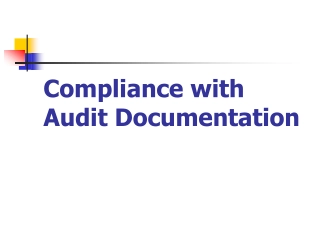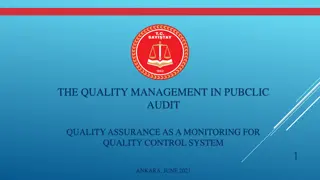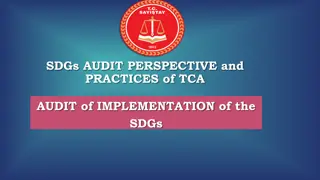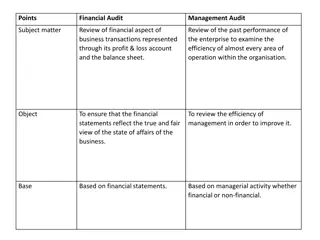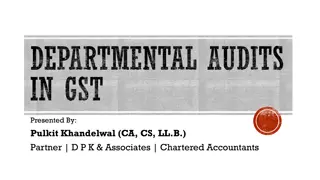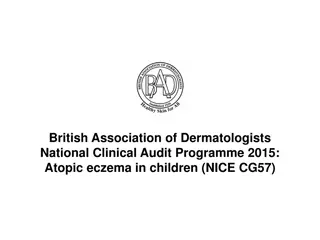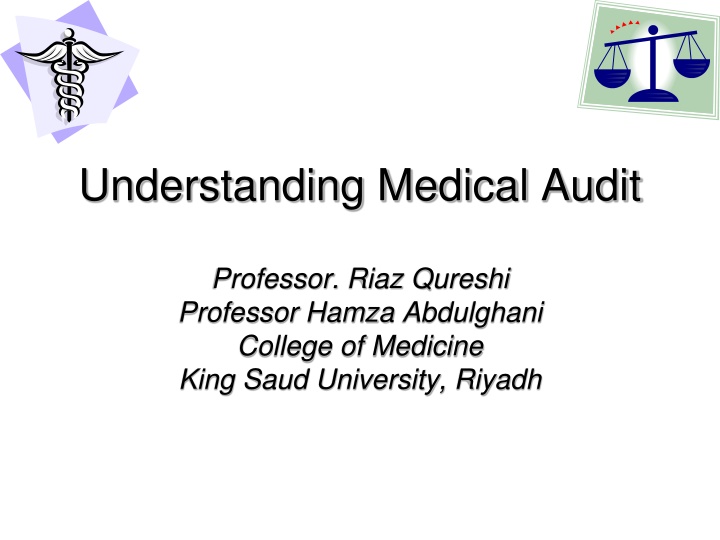
Understanding Medical Audit in Healthcare
Explore the world of medical audit with a focus on assessing, evaluating, and improving patient care. Learn about the framework, terminology, types, and benefits of medical audits. Discover how to plan and execute audits to enhance the quality of healthcare services.
Download Presentation

Please find below an Image/Link to download the presentation.
The content on the website is provided AS IS for your information and personal use only. It may not be sold, licensed, or shared on other websites without obtaining consent from the author. If you encounter any issues during the download, it is possible that the publisher has removed the file from their server.
You are allowed to download the files provided on this website for personal or commercial use, subject to the condition that they are used lawfully. All files are the property of their respective owners.
The content on the website is provided AS IS for your information and personal use only. It may not be sold, licensed, or shared on other websites without obtaining consent from the author.
E N D
Presentation Transcript
Understanding Medical Audit Professor. Riaz Qureshi Professor Hamza Abdulghani College of Medicine King Saud University, Riyadh
Objectives Define Medical Audit (M-Audit). Identify steps (framework) of M-Audit Audit Cycle Recognize important terminology used in M- Audit. Plan for a M-Audit topic. Identify the difference between M-Audit & research Recognize the benefits of M-Audit
Think Pair & Share
Students Task A huge number of our primary care clinics are diabetic patients who are followed in the clinic. We would like to know that the diabetic care is appropriate in PCC. What are the areas to be evaluated? How we can plan for the evaluation of Diabetic care in our clinic?
What is Medical Audit? method used by health professionals to: Assess Evaluate & Improve . the care of patients in a systematic way to enhance their health and quality of life .
Terminology used in M-Audit Self, Peer & External M-Audit Audit Cycle Structure, Process & Outcomes Criteria & Standards Planning for M-Audit Audit Questions Data Sources, Collection & Presentation
Types of Audit Self Audit Peer Audit External Audit
Audit Cycle SET STANDARDS IMPLEMENT CHANGE OBSERVE PRACTICE COMPARE WITH STANDARDS
A framework for assessing care: Audit requires a framework Description, measurement, comparison and evaluation of the quality of health care can be made. Three constituents of quality are: Structure Process Outcomes
Scope of Audit Building Practice equipments Working team STRUCTURE Prescribing habits Hospital referrals Laboratory / X ray use PROCESS Prevention / Control of disease Improved level of functions Relief of symptoms Prevention of premature death Minimizing the cost Increase patient satisfaction OUTCOME
Structure Describes the physical attributes of health care, building, equipments, Employees in the team: # and types, Patient records. Common sense suggests that health care is likely to be more effective if it is carried out in comfortable surroundings with the right equipments and by the most appropriate people.
Process Describes the care given by the health care team, i.e., what the practitioner does, the sum of actions and decisions that describes a person s professional practice. Doctors and nurses tend to identify the process of care with quality because it describes what they do for their patients It reflects their attitudes, knowledge and skills.
Outcomes Describe measures that lie between true process and the definitive outcome. They are easier to measure yet they predict, or are assumed to predict, definitive outcome. Example: The Hb A1C for diabetic patients
Scope of Audit STRUCTURE PROCESS OUTCOME
Outcome** is the change in a patients current and future health status that can be attributed to antecedent health care Therefore the definitive indicators of health Describe the effectiveness of care. For example, did the patient survive a potentially fatal condition ?
Criteria & Standards
Criterion Describe a definable and measurable item of health care, which describes quality, and which can be used to assess it. Example: Females of susceptible age should be immunized against rubella. All diabetic patient should receive pneumococcal vaccination All children requesting attention for acute problems will be seen on the same day.
Standards Describes the level of care to be achieved for any particular criterion. Example: Females of susceptible age should be immunized against rubella. The standard might specify that 98% of the female population at risk should receive protection.
Criterion Standards Should apply to 50% of records. This should apply to : 50% - year 1, 75% - year 2, 95% - year 3, Following the introduction of the standard. Patients records will include summary cards. Structure All patients attending out- patient clinics will have complete nursing assessments. Process Patients with established HTN will have a diastolic level less than 120/80 mm Hg with in the first year of treatment. Outcome- Intermedi ate The target level will be achieved in 80% of cases.
Audit Questions - Examples Are the waiting times for hospital outpatient appointments acceptable? What are the complication rates of a particular type of surgery? Are the consultants to whom patients are referred kind and considerate? Which groups of patients are attending follow-up clinics unnecessarily? How many of our Diabetic patients are controlled?
The use of resources It is important to decide on the maximum level of resources a team is prepared to commit to an audit. In doing this it is also important to ensure that the subject examined is appropriate to the skills and resources available. Resources can be divided into several categories: time, money, people.
Ground rules for choosing an audit subject Is the subject chosen: likely to benefit patients and the practice? relevant to professional practice and development? significant or serious in terms of the process and outcomes of patients care? having potential for improvement? capable of holding the interest and involvement of team members? likely to repay the investment of time, money and effort involved?
Planning an audit: 10 guidelines 1. Define the nature of the perceived problem. Produce a clear written statement of aims. Construct clear audit question. Define the criteria & standard Select the most appropriate method. 6. Identify the main analysis to be made. 7. Start small. 8. Have a short time-scale. 9. Proceed step by step. 10.Indicate how the possible need for change is to be handled. 2. 3. 4. 5.
Data Sources Routine practice data External data Medical records Practice activity analysis Prospective recording Surveys Interviews Direct observation Confidential enquiries
Data collection grid 1 2 3 4 5 20 Marital Status BP Age Sex Drug recorded Case 1 94 M A S Y Case 2 90 M B W Y Case 3 87 F C M N 40
Data presentation card Age (years) BP Antihypertensive prescribed Married Single Total recorded 75 79 9 3 12 13 0 80 - 84 4 2 6 10 1 85 89 3 7 10 2 1 90 94 2 6 8 1 0 95 99 1 3 4 2 Total 19 21 40 28 2
Presentation of data The analysis of data produces results that need to be converted into information which the practice team can understand and to which they can relate Trends or insights must be presented in a visual way that communicates the information effectively.
Benefits of Medical Audit Reducing errors Improve efficiency / effectiveness Demonstrating good care Meeting patients needs / expectations Stimulating education Bidding for resources Effective defense
Medical Audit & Research?
M-Audit Research Based on the comparison of practice against standards Based on an idea (hypothesis), Qs Creates knowledge of current clinical practice and need for improvement Creates new knowledge regarding most beneficial practice Small scale over a short time period Large scale over a long time period Does not necessarily need a statistically valid sample size Needs a statistically valid sample size Basic statistical analysis usually suffices Extensive statistical analysis is required Creates knowledge of current clinical practice and need for improvement Creates new knowledge regarding most beneficial practice Clear responsibility to act on findings No mechanism to act on findings Does not usually require ethical approval Always requires ethics committee approval
Students Task A huge number of our primary care clinics are diabetic patients who are followed in the clinic. We would like to know that the diabetic care is appropriate in PCC. What are the areas to be evaluated? How we can plan for the evaluation of Diabetic care in our clinic?
Planning an audit: 10 guidelines 1. Define the nature of the perceived problem. Produce a clear written statement of aims. Construct clear audit question. Define the criteria & standard Select the most appropriate method. 6. Identify the main analysis to be made. 7. Start small. 8. Have a short time-scale. 9. Proceed step by step. 10.Indicate how the possible need for change is to be handled. 2. 3. 4. 5.
References Making sense of Audit: Donald and Sally Irvine Conducting a clinical practice audit: Canadian Family Physician 2001 Problem based medical audit program: Family Medicine 1998 Audit in Health Care. The purpose of reviewing quality: Irish Medical Journal 1999
THANK YOU Have a nice day

